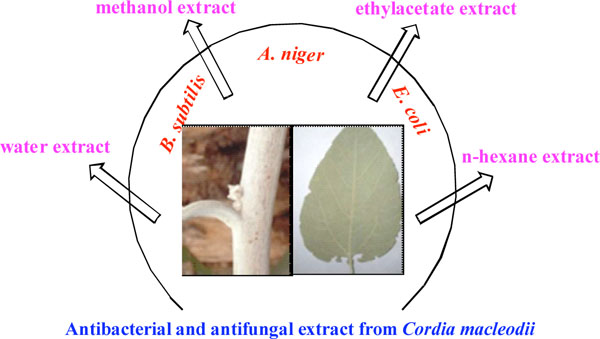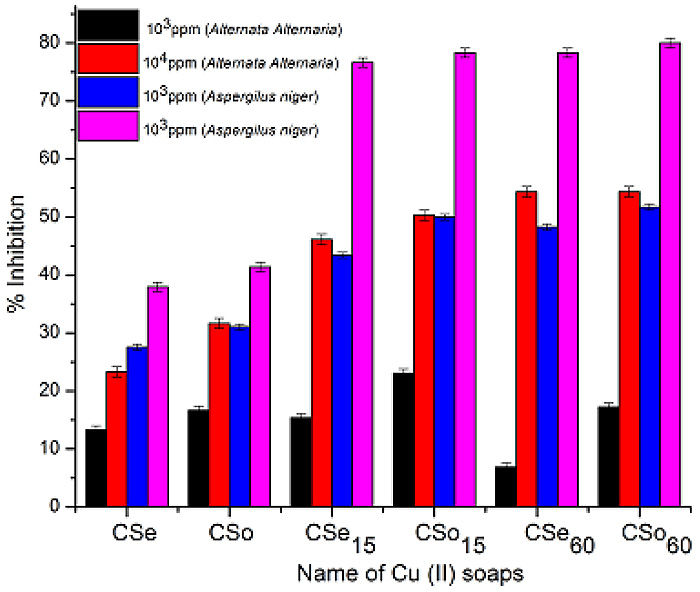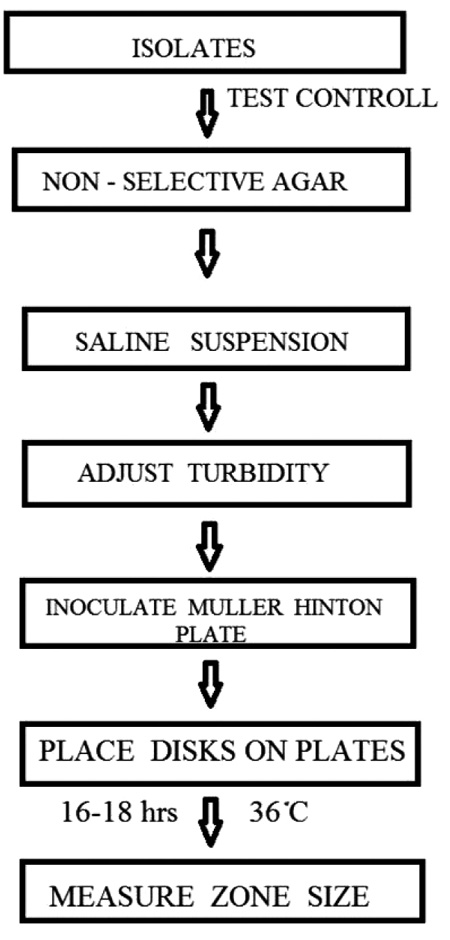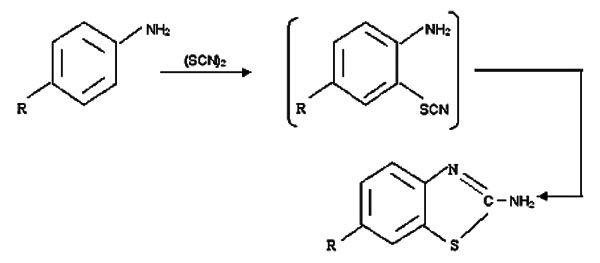RESEARCH ARTICLE
Antimicrobial Evaluation of Leaf and Stem Extract of Cordia macleodii
Deepkumar Joshi1, *, Rinku Patel2, Nupur Patel2, Devendra Patel1, Chintan Pandya2
Article Information
Identifiers and Pagination:
Year: 2014Volume: 1
First Page: 1
Last Page: 3
Publisher Id: PHARMSCI-1-1
DOI: 10.2174/1874844901401010001
Article History:
Received Date: 20/10/2014Revision Received Date: 22/11/2014
Acceptance Date: 5/12/2014
Electronic publication date: 31/12/2014
Collection year: 2014
open-access license: This is an open access article licensed under the terms of the Creative Commons Attribution Non-Commercial License (http://creativecommons.org/licenses/by-nc/3.0/) which permits unrestricted, non-commercial use, distribution and reproduction in any medium, provided the work is properly cited.
Abstract
The leaf and stem of cordia macleodii plant were investigated for evaluating antibacterial and antifungal properties.Different extracts of leaf and stem viz. double distilled water, methanol, ethyl acetate ane n-hexane were collectedand content was optimized for the maximum amount of extraction with varying time of 6 and 12 h. The extracts weretested for their antimicrobial activities against gram-positive bacteria (B. sutilis), gram-negative bacteria (E. coli) andfungi (A. niger). The extracts were found to be more active against bacteria as compared to fungi. It was also observedthat the antibacterial and antifungal potential of the water extracts were found to be excellent as 1A (38 mm) and 1B (22mm) compared to the other extracts.
Graphical Abstract:

INTRODUCTION
Medicinal plants are found to have great potential in healing the wound with minimal discomfort and pain to the patient [1]. Cordia macleodii belonging to Boraginaceae family and familiarly known as Dahiphalas, has green leaves and broad ovate. The leaves of cordia macleodii are found to possess antimicrobial property as reported by Acharya et al. [2]. The flavonoids content present in the leaf of the plant cordia macleodii is reported to exhibit antioxidant and hepatoprotective activities [3]. Also, the HPTLC profile conducted for analyzing the leaf content of the plant, shows the presence of alkaloids, glycosides, tannins at 254 and 366 nm [4]. The biological properties of the solvent extracts of leaf and other part of cordia macleodii have attracted us to study the antimicrobial properties against bacterial and fungal strains.
EXPERIMENTAL
Materials and Methods
Cordia macleodii plant was identified and collected for the analysis by the authentic authority from the Junagadh region of Gujarat state in India. Stem bark and leaves of the plant were cleaned to remove the dust and washed with water and dried. The dried parts were crushed to powder and stored in dry place away from moisture and direct heat. Solvents required for extraction were purchased from Merck Ltd. and SD fine chemicals.
Extraction
Stem and leaf powders around 12 gm were added to 300 ml of solvents (double distilled water, methanol, ethyl acetate and n-hexane) and were exposed to hot extraction method for 6h using Soxhlet method of extraction [5] and 12h by heating at 80°C with constant stirring [6]. The filtration process was carried out using whatman filter paper no. 1, avoiding the loss of solvent. The left over residues were dried and weigh to calculate the extractable matter in various solvents. The crude extract (filtrate) was collected and used for further biological evaluation.
The solvent extracts collected from stem and leaf were numbered in order to identify the samples during further analysis. The water extract collected after 6 h was titled 1A and that after 12 h was named 1B. Similarly, the solvent extracts from methanol, ethylacetate and n-hexane were named 2, 3 and 4, respectively. Notation ‘A’ was used for 6h and ‘B’ for 12h extract for each solvent extract as indicated in Table 1.
Annotation of extracts collected from stem and leaf of Cordia macleodii.
| Time / Extract | Double Distilled Water | Methanol | Ethylacetate | n-hexane |
|---|---|---|---|---|
| 6h | 1A | 2A | 3A | 4A |
| 12h | 1B | 2B | 3B | 4B |
Antibacterial and Antifungal Evaluation
The antimicrobial tests were carried out using well-diffusion method with standard protocols. Each gram-positive, gram-negative bacteria and fungi were employed for testing the antimicrobial potential of the stem and leaf extracts of the plant. B. subtilis (ATCC no. 6633-gram-positive bacteria), E. coli (ATCC no. 25922-gram-negative bacteria) and A. niger (ATCC no. 1015-fungi) were used for antibacterial and antifungal testing of the compounds. Zone of inhibition (mm) was observed for each of the sample ranging from 1A to 4B and the results were reported in the Tables 2 and 3. Antibiotics like ciprofloxacin and fluconazole available in market were used as standard for antibacterial and antifungal analyses respectively.
Antibacterial and antifungal evaluation of different extracts from leaf of Cordial macleodii.
| Extract | Gram-positive bacteria B. subtilis |
Gram-negative bacteria B. subtilis |
Fungi A. niger |
|---|---|---|---|
| 1A | 22 | 0 | 0 |
| 1B | 38 | 0 | 15 |
| 2A | 6 | 0 | 16 |
| 2B | 8 | 0 | 0 |
| 3A | 7 | 0 | 0 |
| 3B | 9 | 0 | 5 |
| 4A | 7 | 0 | 0 |
| 4B | 7 | 0 | 0 |
| Std. | 25 | 24 | - |
| Std. | - | - | 25 |
Values indicated in the table above are Zone of inhibition (mm)
Std. drug for antibacterial activity is ciprofloxacin and antifungal activity is fluconazole
Antibacterial and antifungal evaluation of different extracts from stem of Cordial macleodii.
| Extract | Gram-positive bacteria B. subtilis |
Gram-negative bacteria B. subtilis |
Fungi A. niger |
|---|---|---|---|
| 1A | 4 | 0 | 6 |
| 1B | 16 | 0 | 7 |
| 2A | 6 | 0 | 3 |
| 2B | 13 | 0 | 7 |
| 3A | 3 | 0 | 2 |
| 3B | 7 | 8 | 3 |
| 4A | 3 | 2 | 6 |
| 4B | 19 | 5 | 9 |
| Std. | 25 | 24 | - |
| Std. | - | - | 25 |
Values indicated in the table above are Zone of inhibition (mm)
Std. drug for antibacterial activity is ciprofloxacin and antifungal activity is fluconazole
RESULTS AND DISCUSSION
Antimicrobial Activity
The antimicrobial results showed in Tables 2 and 3 exhibited promising results against gram-positive bacteria B. subtilis and fungi A. niger, but showed poor results against gram-negative bacteria E. coli, when compared with the standards ciprofloxacin and fluconazole.
Antibacterial and Antifungal Results of Leaf Extracts
From Table 2, it was very clearly observed that none of the extracts was active against gram-negative bacteria E. coli. Water extracts 1A (6h) and 1B (12h) exhibited excellent results (22 and 38 mm) against gram-positive bacteria B. subtilis. Leaf extract 1A was found to be inactive against A. niger, but exhibited moderate zone of inhibition against the same fungal strain. As compared to the standards ciprofloxacin and fluconazole, other extracts exhibited low activity viz. 2A, 2B, 3A, 3B, 4A and 4B against the gram-positive bacterial strain B. subtilis. Methanol extract 2A showed moderate results (15 mm) and ethylacetate extract 3B exhibited poor activity (5 mm) against A. niger
Antibacterial and Antifungal Screening of Stem Extracts
For testing antibacterial and antifungal potentials of the stem extracts as indicated in Table 3, same microbial strains B. subtilis, E. coli and A. niger were utilized. Very few extracts were found to show positive results against gram-negative bacteria E.coli viz. 3B (ethylacetate-8 mm), 4A (n-hexane-2 mm) and 4B (n-hexane-5 mm). All the extracts showed poor to moderate results against B. subtilis (3 mm to 19 mm) as compared to the standard (25 mm). Among those, Water extract 2A and n-hexane extract 4B, exhibited moderate results of 16 mm and 19 mm irrespectively. Stem extracts (1A to 4B) were found to possess low antifungal property when tested against A. niger.
CONCLUSION
The antimicrobial results very well indicated that the water (1B) and n-hexane (4B) extracts collected after 12 hrs were found to show excellent results, also, the antibacterial potential of water extract of leaf (1B) of Cordia macleodii was found to be more than the standard drug ciprofloxacin. Overall, the extracts were active against gram-positive bacteria B. subtilis and fungi A. niger. It was also observed that the extracts collected after 12 hrs exhibited comparatively more antibacterial and antifungal values than the extracts collected after 6 h. Further optimization in the extraction method and identification of the chemical constituent in the leaf and stem extracts can help in providing a newer antimicrobial agent to the society.
CONFLICT OF INTEREST
The authors confirm that this article content has no conflict of interest.
ACKNOWLEDGEMENTS
Authors are thankful to Kadi Sarva Vishwvidyalaya, Gandhinagar and Sarva Vidyalaya Kelavani Mandal, Kadi for providing infrastructural facilities to the researchers to carry out the work. Authors are thankful to Prof. B. A. Golakiya for his kind help in literature survey and identification and collection of Cordia macleodii plant.













